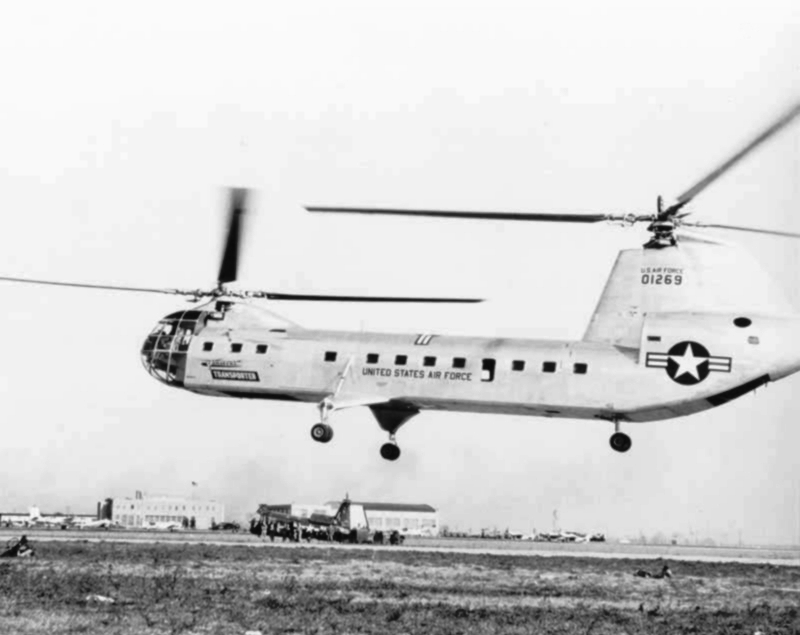Piasecki YH-16B Transporter on:
[Wikipedia]
[Google]
[Amazon]
The Piasecki H-16 Transporter (company designation PV-15) was a tandem-rotor transport or rescue helicopter designed by Frank Piasecki and built by
 ;XH-16/YH-16
: Powered by two Pratt & Whitney R-2180-E Twin Wasp E radial engines and room for 43 troops, one built later converted to a YH-16B.
;YH-16A
: Powered by two Allison T38-A-10 1,800 shp
;XH-16/YH-16
: Powered by two Pratt & Whitney R-2180-E Twin Wasp E radial engines and room for 43 troops, one built later converted to a YH-16B.
;YH-16A
: Powered by two Allison T38-A-10 1,800 shp

Piasecki H-16 page"Biggest Transport Helicopter Cruises 150 Miles Per Hour."
''Popular Mechanics'', January 1954, p. 119, bottom of page. {{USAF helicopters H-16
Piasecki Helicopter
The Piasecki Helicopter Corporation was an American designer and manufacturer of helicopters in Philadelphia and nearby Morton, Pennsylvania, in the late 1940s and the 1950s. Its founder, Frank Piasecki, was ousted in 1956 and started a new ...
. The prototypes were evaluated by the United States Air Force
The United States Air Force (USAF) is the Air force, air service branch of the United States Department of Defense. It is one of the six United States Armed Forces and one of the eight uniformed services of the United States. Tracing its ori ...
and Army
An army, ground force or land force is an armed force that fights primarily on land. In the broadest sense, it is the land-based military branch, service branch or armed service of a nation or country. It may also include aviation assets by ...
, but the crash of the second test aircraft led to cancelling the project.
Design and development
Given the company designation PV-15, the tandem-rotor helicopter was designed by company founder Frank Piasecki. The design was publicly shown for the first time on 15 September 1953 at thePhiladelphia airport
Philadelphia International Airport is the primary international airport serving Philadelphia, Pennsylvania, United States. It served 30.8 million passengers annually in 2024, making it the busiest airport in Pennsylvania and the 21st-busies ...
.
Operational history
Crash
On 5 January 1956, the second YH-16 test aircraft crashed while returning to Philadelphia from a test flight over New Jersey.Piasecki Helicopter Corporation newsletter, January 1956 The cause of the crash was later determined to be the aftslip ring
A slip ring is an electromechanical device that allows the transmission of Electric power, power and electrical Signal, signals from a stationary to a rotating structure. A slip ring can be used in any Electromechanics, electromechanical system ...
, which carried flight data from the instrumented rotor blades to the data recorders in the cabin. The slip ring bearings seized, and the resultant torque load severed the instrumentation standpipe inside the aft rotor shaft. A segment of this steel standpipe tilted over and came into contact with the interior of the aluminum rotor shaft, scribing a deepening groove into it. The rotor shaft eventually failed in flight, which in turn led to the aft blades and forward blades desynchronizing and colliding.
The aircraft was a total loss; the two test pilots, Harold Peterson and George Callahan, were killed. This led to the cancellation not only of the YH-16, but also the planned 69-passenger YH-16B version.
Variants
 ;XH-16/YH-16
: Powered by two Pratt & Whitney R-2180-E Twin Wasp E radial engines and room for 43 troops, one built later converted to a YH-16B.
;YH-16A
: Powered by two Allison T38-A-10 1,800 shp
;XH-16/YH-16
: Powered by two Pratt & Whitney R-2180-E Twin Wasp E radial engines and room for 43 troops, one built later converted to a YH-16B.
;YH-16A
: Powered by two Allison T38-A-10 1,800 shp turboshaft
A turboshaft engine is a form of gas turbine that is optimized to produce shaft horsepower rather than jet thrust. In concept, turboshaft engines are very similar to turbojets, with additional turbine expansion to extract heat energy from the ex ...
engines; previously designated XH-27.
;YH-16B
: Prototype XH-16A re-engined with two Allison T56-A-5 2,100 shp turboshaft engines.
Specifications (YH-16B)
See also
References
* *External links
Piasecki H-16 page
''Popular Mechanics'', January 1954, p. 119, bottom of page. {{USAF helicopters H-16
Piasecki H-16
The Piasecki H-16 Transporter (company designation PV-15) was a tandem-rotor transport or rescue helicopter designed by Frank Piasecki and built by Piasecki Helicopter. The prototypes were evaluated by the United States Air Force and United State ...
1950s United States helicopters
Tandem rotor helicopters
Twin-turbine helicopters
Military transport helicopters
Cancelled military aircraft projects of the United States
Aircraft first flown in 1953